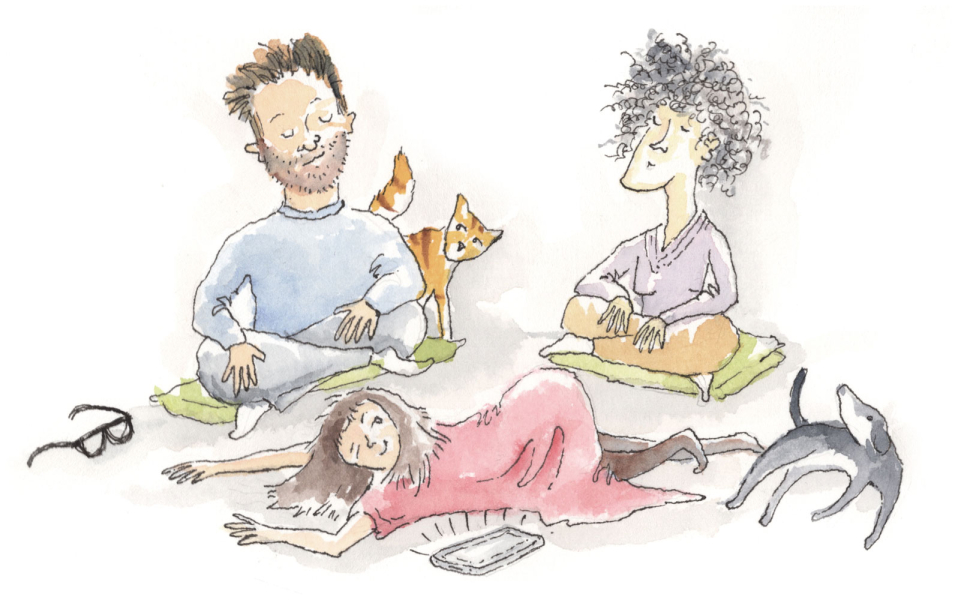Start your free 14-day full trial. No credit card needed.
The Family Sit
A family's attempt at practicing mindfulness


“Routine is the writer’s salvation,” said Flannery O’Connor. It’s also the family’s salvation for getting out the door in the morning. With extracting an eight-year-old girl from bed, exercise for the wife, two different breakfasts, the peril of kid’s hair brushing, a hungry dog, an indifferent and prattling cat, my own cup of coffee and Twitter feed, two lunches, my wife navigating her curly hair, the distractions of piano or dolls or tiny detritus to be played with, topped by their twenty-minute commute, it’s a wonder we keep it together. And we do, most mornings. There is an order we follow, who gets up when, lunches made while breakfast cooks, wife in the shower, kid brushing her hair, crescendoing in cajoling a teeth brushing then out the door.
Our busy mornings, I suspect, are average. I’m sure on the morning-get-out-the-door curve, we’re in the middle of craziness. Yet adding one more thing to our list felt precarious. For the last month, we have tried.
Somewhere around 8am, when their departure time is nearing, my wife says, “Should we have a sit?”
A sit. The family sit—the name my wife gave it. She has a superior talent in naming stuff. The family sit is when the three of us grab a pillow and some floor—the kid sprawled—and we practice a guided mindfulness meditation. We’re still learning to be consistent, to make sure we have that extra ten minutes before the girls are out the door and I head to my home office. Surprisingly, we’ve had almost no resistance from our daughter. The biggest challenge has been making the time. It’s been a challenge.
Why mindfulness? Why now?
A couple of years ago I had a brief though fruitful flirtation with mindfulness meditation. Where I failed was making it a part of my routine. Once the girls were off and I should have taken the time to meditate, I gave into the lure of the big fat Internet on the big fat screen in my office, saying to myself I’d take a break and do it later. I didn’t and slowly my practice shriveled and passed into obscurity like so many forgotten tweets.
We’ve had almost no resistance from our daughter. The biggest challenge has been making the time.
When our daughter was having struggles with her emotions at school causing her (and us) frustration, we wanted to find skills to free her from feeling overwhelmed. Skills my wife and I could use as well. This world is filled with unending distraction which infiltrates us and turns our already busy minds into one of those computers going bonkers in old movies, lights flashing, reels whizzing, and us pushing buttons and flicking levers to just make the damn thing stop.
The deep and lasting effects of a consistent meditation practice are so established there’s no need to list them here. Meditation’s association with the mystical—particularly new-agey-ness in the U.S.—can bring a stigma of the hippy and the dippy. I understand the turnoff. This is not to discount a couple millennium of a sacred pursuit; it’s just not my thing. What appeals to me is the practical side of meditation. The more I learn how my mind works, the better I get at curbing a crappy attitude, a quick temper, and selfish actions.
So, introduction to mindfulness, part two, family style. Back in my first attempt, I had read a bit on how to meditate, grabbed a pillow, and sat. The world of guided meditation apps wasn’t what it is now. I wish it was. I think I would have had more success. While meditation is a highly personal journey, having a teacher is helpful. Once we decided to practice as a family, I did a some research into guided family and kids’ meditations on YouTube.
Choosing a guided meditation video for the family and kids
When choosing a guided meditation video, personal preference is going to be a factor: the sound of the guide’s voice, with or without music, how much intro, how long, etc. Before you jump in, I encourage listening without the family to make sure it’s what you’re looking for.
I also found a conflation of relaxation and meditation themes. Yes, meditation is relaxing, but mindfulness is something different and deeper. We’re not trying to quiet the mind to, for example, go to sleep. Mindfulness meditation means observing how our mind works, how our feelings turn into thoughts, and learning to unchain ourselves from those feelings and thoughts to live a more peaceful, balanced life.
Our favorite so far has been Peace Out, a series from Cosmic Kids Yoga. Jamie, the guide, is terrific. There’s a calmness in her voice without being saccharine and she subtly introduces meditation skills in engaging and friendly themed video guides. Ironically, the playlist is called Guided Relaxation for Kids—which I said is probably not what you’re looking for. But interspersed in the visualizations are mindfulness cues that are laying the groundwork for a more sophisticated practice down the road. Remember, kids’ attention spans are shorter than ours—if not by much—and you want to accompany them on their meditation journey, not take them on your own.
Here’s what we’ve learned so far:
Keep expectations low
No one gets meditation on the first try, or second or third and so on. It takes time and practice, especially for the younger ones. Don’t be hard on yourself or them. If you treat “the sit” like another chore to checkoff and done right, you’ll miss all the good that can come from meditating together.
Pick the quietest place you can
Turn off the screens, the tv, the radio, etc. It doesn’t have to be a vacuum without sound, but the less distraction the better. You might need to put the pets outside in the beginning. Our dog and cat thought us sitting on the floor was a great time for attention. Meditation is already challenging without a critter trying to get some petting action.
Let kids be kids
Our daughter wanted to bring her favorite blanket and pillow to where we sit in the beginning. No problem. And while my wife and I sat crossed-legged in our best yogi pose, she splayed herself, covered in a blanket. No problem. It is important to for us to be still, but in the beginning let the kid participate how she wants.
Hide the screens
We use a phone to play the video and during one session I noticed my daughter was extra fidgety. I asked her why afterwards. I had left the phone face-up on the floor between us and she couldn’t help but keep staring at the screen, even though the video was a static image. The appeal of screens—to all of us—is huge. So put the phone face down or close the laptop screen most of the way.
Talk about your experiences
When we’re done, it’s tempting for me to try and get us back on track so the girls are out the door on time. No good. Take a few moments when the sit is done to talk about how it felt—the good and the bad. If there was a visualization, ask what each other imagined. This is usually pretty fun. Lastly, come back later in the day and see if anyone put into practice what they learned that morning.
Take a few moments when the sit is done to talk about how it felt—the good and the bad.
Make it routine
This is much easier said than done. We’re still challenged to make the time in the morning, as we had a set routine that was already feeling tight on time. But if you’re consistent, everyone will see and feel the result. Look for ways to shorten or combine tasks in the morning, even getting up ten minutes earlier (ouch).
Write down your experiences
It’s helpful to log how the sessions go, what skills were introduced, and even how each of you put the skills to use. There’s so much competition for our attention and thoughts, by writing down your meditation experiences, you’re more likely to remember them and more inclined to put them into practice. Too, as we started this journey to help our daughter with her emotions, I can go back to sessions we’ve done and remind her about skills we’ve learned and if she’s tried any during frustrating times. (She has—and so have we!)
A kind of group therapy
With commutes, Taekwondo, piano, my music nights, local volunteering, the wife’s theater shows, and the daily onslaught of information and activity, we realized it was important to set aside time for the three of us to be, well, just the three of us. We try to do dinner at the table multiple nights a week usually followed by a game before bed, plus things for the three of us on the weekends. The Family Sit has added to that. It’s nice to be with one another in quiet but everyone present, each of us moving towards a similar goal. As they say, time is what you make of it, but it’s also when you make it. If family meditation is your goal, you’ll have to be pragmatic with schedules. And putting your mind to creating a routine will open your and your family’s mind to a wonder of possibilities.

March 15th 2018
Don't miss out on Daily Minded insights in your inbox

Journal Everyday
By submitting your email, you agree to our terms of sevice and privacy policy.

Comments